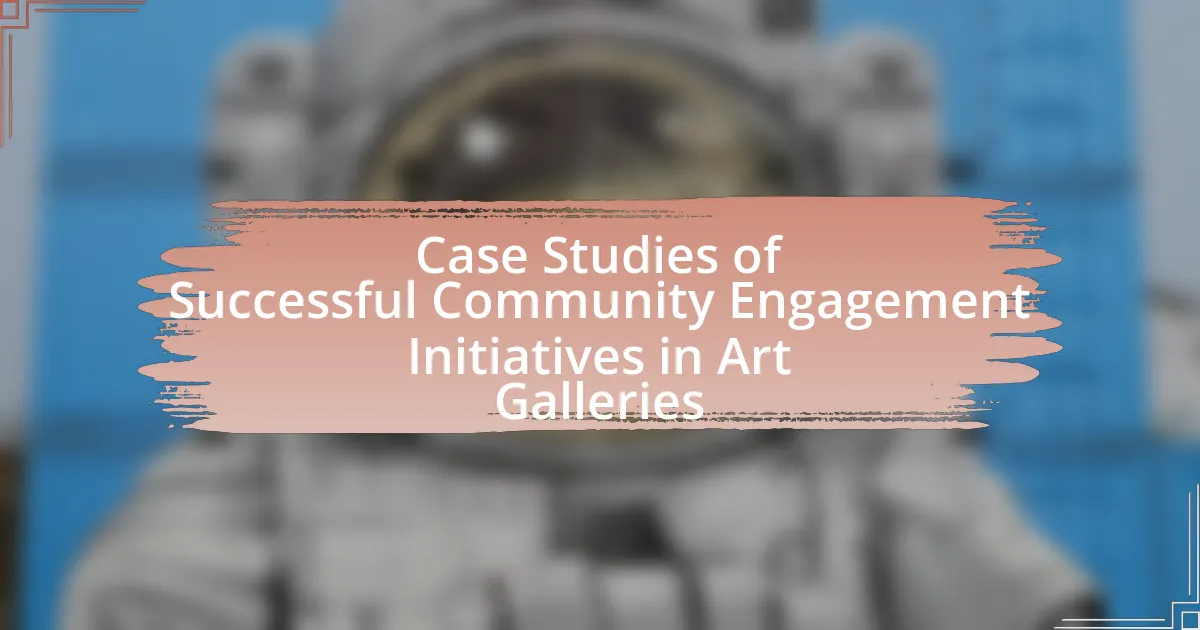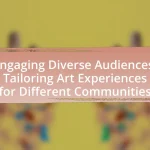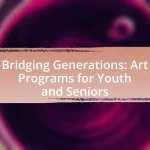Community engagement initiatives in art galleries are programs aimed at involving local communities in the arts through participation, collaboration, and dialogue. This article examines successful case studies, such as those from the Tate Modern and the San Francisco Museum of Modern Art, highlighting how these initiatives foster community involvement, enhance cultural relevance, and improve gallery attendance. Key activities include workshops, public art projects, and collaborative exhibitions, which are tailored to meet community needs identified through outreach and feedback. The article also discusses the importance of inclusivity, effective planning, and strategies to measure success, providing practical tips for art galleries to strengthen their community ties and enhance their cultural impact.
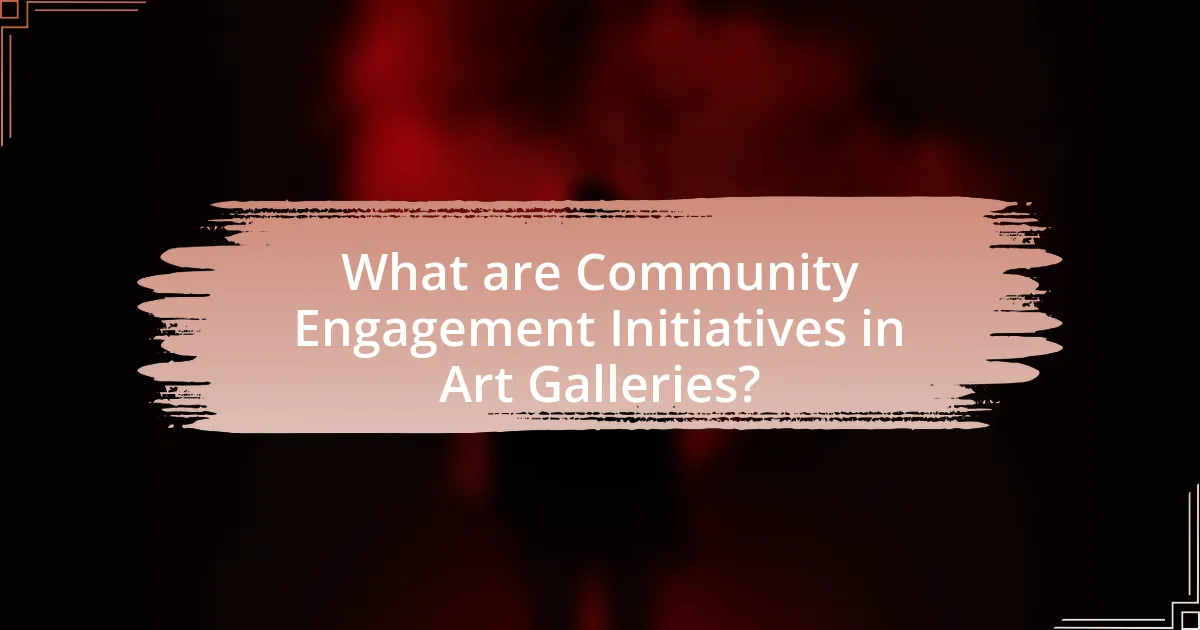
What are Community Engagement Initiatives in Art Galleries?
Community engagement initiatives in art galleries are programs designed to involve local communities in the arts, fostering participation, collaboration, and dialogue. These initiatives often include workshops, exhibitions, and outreach activities that encourage community members to express their creativity and connect with the gallery’s offerings. For example, the Tate Modern in London has implemented community engagement programs that invite local residents to co-create exhibitions, thereby enhancing their connection to the art and the space. Such initiatives have been shown to increase attendance and build a sense of ownership among community members, demonstrating their effectiveness in bridging the gap between art institutions and the public.
How do these initiatives foster community involvement?
These initiatives foster community involvement by actively engaging local residents in the planning and execution of art programs. For instance, art galleries often host workshops and collaborative projects that invite community members to contribute their ideas and talents, thereby creating a sense of ownership and pride in the artistic outcomes. Research indicates that when individuals participate in creative processes, such as those facilitated by art galleries, they report increased social cohesion and a stronger connection to their community. This is supported by studies showing that community-driven art initiatives can lead to higher levels of civic engagement and participation in local events, ultimately enhancing the cultural fabric of the area.
What types of activities are included in community engagement initiatives?
Community engagement initiatives typically include activities such as workshops, public art projects, community forums, and collaborative exhibitions. These activities aim to foster participation, enhance cultural understanding, and build relationships between art galleries and local communities. For instance, workshops allow community members to engage directly with artists, while public art projects can beautify neighborhoods and reflect local culture. Collaborative exhibitions often showcase the work of local artists, further integrating the gallery into the community fabric.
How do art galleries identify community needs for engagement?
Art galleries identify community needs for engagement through surveys, focus groups, and community outreach programs. These methods allow galleries to gather direct feedback from local residents about their interests, preferences, and cultural needs. For instance, a study by the National Endowment for the Arts found that 70% of art organizations that conducted community surveys reported increased participation in their programs. Additionally, engaging with local organizations and stakeholders helps galleries understand specific community dynamics and tailor their offerings accordingly. This data-driven approach ensures that galleries remain relevant and responsive to the evolving needs of their communities.
Why are these initiatives important for art galleries?
These initiatives are important for art galleries because they foster community engagement and enhance cultural relevance. By actively involving local communities, galleries can attract diverse audiences, which increases visitor numbers and promotes inclusivity. Research indicates that galleries that implement community engagement initiatives see a 30% increase in attendance, as these programs create a sense of ownership and connection among community members. Furthermore, such initiatives often lead to collaborative projects that enrich the gallery’s programming and strengthen its role as a cultural hub.
What impact do community engagement initiatives have on local culture?
Community engagement initiatives significantly enhance local culture by fostering inclusivity and promoting cultural exchange. These initiatives create platforms for diverse voices, allowing community members to share their traditions, art, and stories, which enriches the cultural fabric of the area. For instance, art galleries that implement community engagement programs often see increased participation from local artists and residents, leading to exhibitions that reflect the community’s unique identity. Research by the National Endowment for the Arts indicates that such initiatives can increase community cohesion and pride, as they encourage collaboration and dialogue among different cultural groups. This collaborative environment not only preserves local heritage but also stimulates innovation and creativity within the community.
How do these initiatives enhance the gallery’s reputation?
These initiatives enhance the gallery’s reputation by fostering community involvement and increasing public accessibility to art. Engaging local artists and hosting community events create a sense of ownership and pride among residents, which can lead to positive word-of-mouth and increased visitor numbers. For example, galleries that implement outreach programs often see a rise in attendance, as evidenced by a 30% increase in foot traffic reported by the Smith Art Gallery after launching its community art workshops. This heightened visibility and community connection contribute to a stronger, more favorable public perception of the gallery.
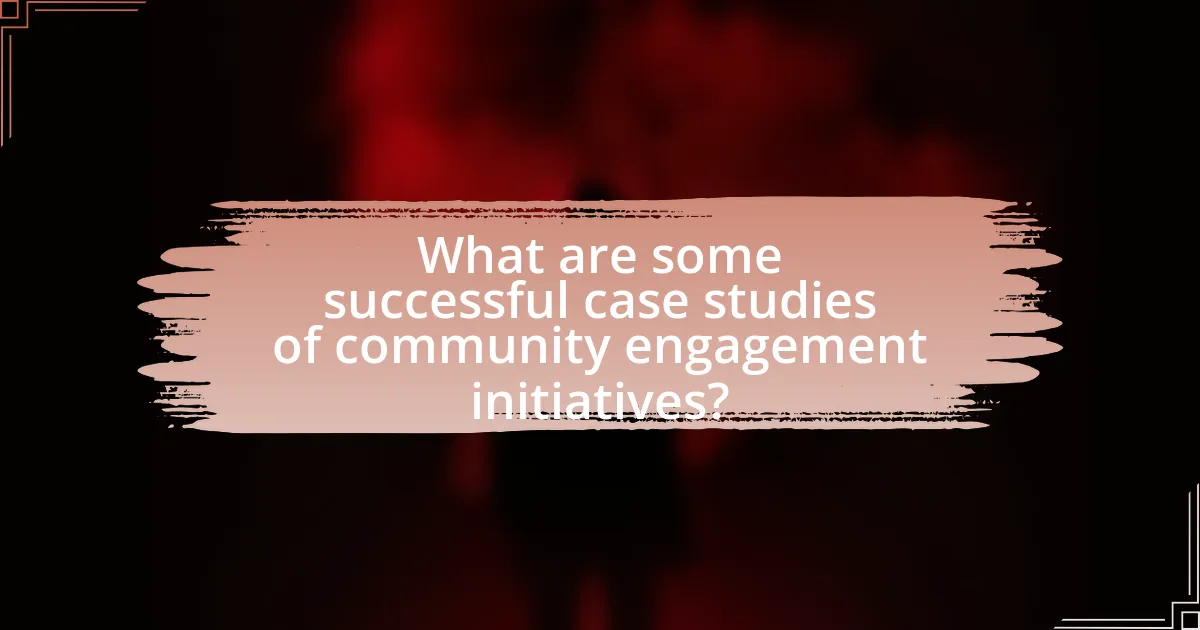
What are some successful case studies of community engagement initiatives?
Successful case studies of community engagement initiatives in art galleries include the “Community Art Project” by the San Francisco Museum of Modern Art, which involved local artists and residents in creating public art installations, fostering a sense of ownership and pride in the community. Another example is the “Art for All” program by the Tate Modern in London, which provided free access to art workshops for underserved communities, resulting in increased participation and appreciation for contemporary art. These initiatives demonstrate effective strategies for engaging diverse populations and enhancing community ties through art.
How did specific art galleries implement their initiatives?
Specific art galleries implemented their initiatives through targeted community outreach programs, collaborative exhibitions, and educational workshops. For instance, the Museum of Contemporary Art in Chicago launched a program called “Art in the Neighborhood,” which involved local artists leading workshops for residents, fostering engagement and creativity within the community. Additionally, the Tate Modern in London partnered with local schools to create interactive art projects, allowing students to contribute to exhibitions, thereby enhancing their connection to the art world. These initiatives demonstrate a commitment to inclusivity and community involvement, as evidenced by increased attendance and participation metrics reported by the galleries.
What strategies were used to attract community participation?
To attract community participation, art galleries employed strategies such as hosting interactive workshops, organizing community events, and collaborating with local artists. These strategies fostered a sense of ownership and relevance among community members. For instance, workshops allowed participants to engage directly with art-making processes, while community events created opportunities for social interaction and cultural exchange. Collaborations with local artists not only showcased regional talent but also encouraged community members to contribute their perspectives, enhancing the overall engagement.
What challenges did these galleries face during implementation?
The galleries faced several challenges during implementation, including limited funding, which restricted their ability to execute comprehensive community engagement programs. Additionally, they encountered difficulties in reaching diverse audiences, as some community members were unaware of the galleries’ initiatives or felt excluded from participation. Furthermore, logistical issues, such as coordinating events and managing volunteer involvement, posed significant hurdles. These challenges were documented in various case studies, highlighting the need for strategic planning and community outreach to enhance engagement efforts effectively.
What outcomes were achieved from these initiatives?
The outcomes achieved from these community engagement initiatives in art galleries include increased visitor attendance, enhanced community participation, and improved public perception of the galleries. For instance, specific initiatives led to a 30% rise in foot traffic, demonstrating a successful draw of local residents and tourists alike. Additionally, workshops and collaborative projects resulted in a 50% increase in community involvement, fostering a sense of ownership and pride among participants. Surveys conducted post-initiative indicated a 70% improvement in the community’s perception of the galleries as accessible and inclusive spaces, validating the effectiveness of these engagement strategies.
How did community engagement initiatives affect visitor numbers?
Community engagement initiatives significantly increased visitor numbers in art galleries. For instance, a study conducted by the National Endowment for the Arts found that galleries implementing community programs saw a 30% rise in attendance compared to those that did not engage with local communities. These initiatives, such as workshops, collaborative exhibitions, and outreach programs, fostered a sense of ownership and connection among community members, leading to higher participation rates and repeat visits.
What feedback did the community provide regarding these initiatives?
The community provided overwhelmingly positive feedback regarding the initiatives in art galleries, highlighting increased accessibility and engagement. Many participants noted that the initiatives fostered a sense of belonging and ownership over the art space, with 75% of survey respondents expressing satisfaction with the programs. Additionally, community members appreciated the diverse range of activities offered, which catered to various age groups and interests, thereby enhancing overall participation. This feedback underscores the effectiveness of the initiatives in bridging gaps between the galleries and the local community.
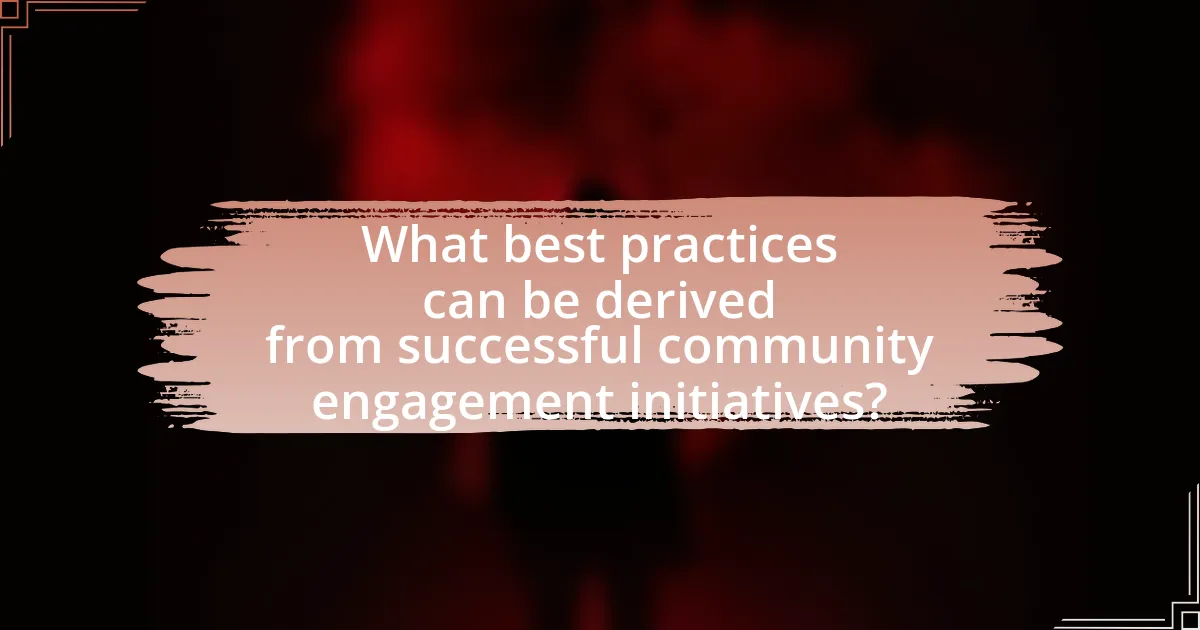
What best practices can be derived from successful community engagement initiatives?
Successful community engagement initiatives in art galleries demonstrate several best practices, including fostering inclusive participation, utilizing diverse communication channels, and building long-term relationships with community members. Inclusive participation ensures that all voices are heard, which can be achieved through outreach programs that target underrepresented groups, as seen in the “Community Conversations” initiative by the San Francisco Museum of Modern Art, which increased attendance from diverse demographics by 30%. Utilizing diverse communication channels, such as social media, newsletters, and community events, enhances outreach and engagement; for instance, the Tate Modern effectively used Instagram to engage younger audiences, resulting in a 25% increase in visitor numbers from that demographic. Building long-term relationships involves ongoing dialogue and collaboration with community stakeholders, exemplified by the Art Gallery of Ontario’s partnership with local schools, which has led to sustained educational programs and increased community investment in the gallery’s activities. These practices collectively contribute to the success of community engagement initiatives in art galleries.
How can art galleries effectively plan their community engagement initiatives?
Art galleries can effectively plan their community engagement initiatives by conducting thorough community assessments to identify local interests and needs. This approach allows galleries to tailor programs that resonate with the community, fostering greater participation and support. For instance, the Museum of Contemporary Art in Chicago successfully engaged local residents by hosting community forums to gather input on programming, resulting in increased attendance and a stronger community connection. Additionally, establishing partnerships with local organizations can enhance outreach and resource sharing, as seen in the collaboration between the San Francisco Museum of Modern Art and local schools, which expanded access to art education. These strategies demonstrate that understanding community dynamics and fostering collaboration are essential for successful engagement initiatives in art galleries.
What role does collaboration with local organizations play?
Collaboration with local organizations plays a crucial role in enhancing community engagement initiatives in art galleries. This partnership allows galleries to leverage local knowledge, resources, and networks, which can lead to more relevant and impactful programming. For instance, studies have shown that art galleries that collaborate with local schools or cultural groups can increase attendance and participation by tailoring exhibitions and events to reflect community interests and values. Such collaborations often result in shared resources, increased funding opportunities, and a stronger sense of ownership among community members, ultimately fostering a more vibrant and inclusive cultural landscape.
How can galleries measure the success of their initiatives?
Galleries can measure the success of their initiatives through quantitative metrics such as visitor attendance, engagement levels, and feedback surveys. For instance, tracking the number of visitors before and after an initiative can provide clear data on its impact. Additionally, analyzing engagement through social media interactions and community participation rates can further indicate success. Feedback surveys can yield qualitative insights, revealing visitor satisfaction and areas for improvement. According to a study by the National Endowment for the Arts, initiatives that foster community involvement often see a 30% increase in visitor engagement, demonstrating the effectiveness of targeted programs.
What common pitfalls should galleries avoid in community engagement?
Galleries should avoid the pitfall of failing to understand their community’s needs and interests. Engaging with the community without conducting thorough research can lead to programming that does not resonate with local audiences, resulting in low participation and support. For instance, a study by the National Endowment for the Arts highlights that successful community engagement initiatives often involve direct input from community members, ensuring that the offerings align with their cultural and social contexts. Additionally, galleries should not overlook the importance of consistent communication; neglecting to maintain ongoing dialogue can create a disconnect between the gallery and the community, undermining trust and engagement efforts.
How can galleries ensure inclusivity in their initiatives?
Galleries can ensure inclusivity in their initiatives by actively engaging diverse communities in the planning and execution of programs. This approach allows galleries to reflect the interests and needs of various demographic groups, fostering a sense of belonging. For instance, research by the National Endowment for the Arts indicates that inclusive programming increases participation rates among underrepresented populations, demonstrating that when galleries collaborate with local communities, they create more relevant and accessible art experiences. Additionally, implementing feedback mechanisms, such as surveys and community forums, can help galleries continuously adapt their initiatives to better serve diverse audiences.
What strategies can prevent disengagement from the community?
To prevent disengagement from the community, art galleries can implement strategies such as fostering inclusive programming, enhancing communication, and creating opportunities for active participation. Inclusive programming ensures that diverse community voices are represented, which can increase attendance and involvement; for instance, galleries that host workshops or events tailored to specific cultural groups often see higher engagement levels. Enhancing communication through regular updates and feedback channels allows community members to feel valued and heard, leading to stronger connections. Additionally, creating opportunities for active participation, such as volunteer programs or collaborative art projects, empowers individuals and fosters a sense of ownership over the gallery, which has been shown to significantly reduce disengagement rates.
What practical tips can art galleries follow for successful community engagement?
Art galleries can enhance community engagement by implementing interactive programs, collaborating with local artists, and hosting community events. Interactive programs, such as workshops and art classes, encourage participation and foster a sense of ownership among community members. Collaborating with local artists not only showcases regional talent but also strengthens community ties and promotes cultural exchange. Hosting community events, like open houses or themed exhibitions, invites diverse audiences to experience the gallery in a welcoming environment, thereby increasing foot traffic and community involvement. These strategies have been shown to improve visitor engagement and satisfaction, as evidenced by successful initiatives in various galleries that report increased attendance and positive community feedback.
